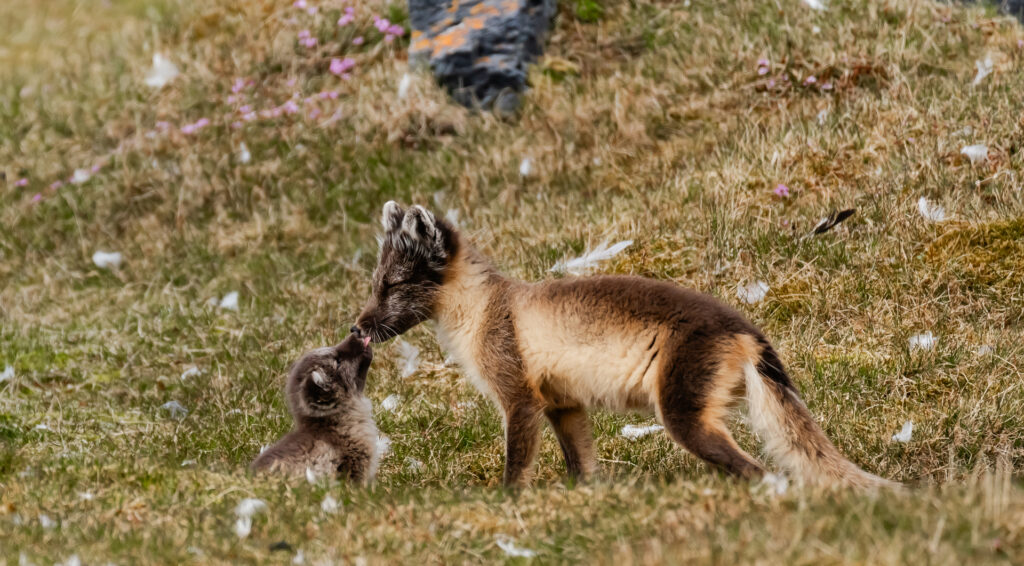During your shore excursions in the Arctic, you may want to keep your eye out for a small creature that’s sporting a large, fluffy tail. Extremely adorable, Arctic foxes are one of the many animals to call this cold area of the world home. They may be hard to spot at first, with fur that changes according to the season, but you’ll definitely be ecstatic if you spot this small, four-legged mammal.
Arctic foxes have thick, luscious fur all over their body that’ll definitely warm your heart upon setting your eyes on one. In this tundra terrain, it’s really spectacular when you learn about the many adaptations of this animal that allows it to withstand the freezing temperatures. Although Arctic foxes can easily be mistaken for a wolf, as part of the canid family, their adaptations set this furry friend apart from the rest of its family.

Meet the Arctic fox
Despite their cute appearance, Arctic foxes are extremely hardy creatures. Their fur allows them to survive up to -50 degrees Celsius, as reported by National Geographic. Even the bottoms of their paws have fur, similar to the hare, to prevent heat loss.
Other adaptations that promote heat retention are their short legs and muzzles, and rounded ears – reducing the surface area on their bodies in which heat can be lost.
They live in a tundra terrain, which is the coldest out of all the biomes (large ecological areas on the earth’s surface). There aren’t many trees in the Arctic, making for little vegetative cover to shelter from frosty winds. When faced with a blizzard, arctic foxes will use their bushy tails, called a brush, to shield their face, and bury into the snow for safety.
Survival in the Arctic
In such a cold environment, food can be scarce. If you so happen to see a polar bear roaming around during your journey, keep your eyes peeled for the Arctic fox. They have a habit of following polar bears, just to snack on their leftovers – smart move!
Besides scavenging for leftovers, the Arctic fox will eat lemmings, fish, and the young of birds, including their eggs. During winter, their hearing and smell senses will drive the fox to tunnelling animals beneath the snow, usually the pups of ringed seals. They will then pounce through the ice, smashing through and catching their prey with quick agility.
Their snowy white fur helps their body blend into the ice, but it doesn’t stay this way for long. When summer draws near, the Arctic fox’s fur thins out to a brown or grey coat. The foxes that live closer to a rocky shoreline may have darker grey-blue coats to help them blend into the terrain. According to the Canadian Geographic (CG), the Arctic fox is the only canid species to change its fur colour for summer.
In terms of reproduction, the Arctic fox doesn’t do too shabby – their litter size can range from six to 14 pups, which the CG states is the largest recorded litter for wild mammals in the animal kingdom.

Try your luck at spotting the Arctic fox!
Your best chances to see an Arctic fox in action are in Svalbard, Greenland and the Canadian Arctic from July to September, just after litters of pups have been born. Make sure you have your camera powered up, on and ready to get a snapshot of this cutie!
If you’d like more information on travelling to the land of the Arctic fox, contact our team today.
Svalbard in Depth
Expedition
On this extended exploration of the Svalbard archipelago, there is ample time to enjoy the best of this magical region, a world of near-endless daylight, where polar bear sightings quicken...
15 Days
From GBP £13,945.50/pp
Iceland, Jan Mayen, Svalbard
Expedition
Welcome to AE Expeditions’ Iceland, Jan Mayen, Svalbard expedition.From the lush green mosses and bustling bird cliffs of Iceland to the stark, sublime volcanic beauty of Jan Mayen and following...
13 Days
From GBP £8,076.00/pp
Greenland Odyssey
Expedition
Experience the enormity of Greenland – the world’s largest island – where jagged peaks pierce azure skies, and countless glaciers snake their way towards the coast. Sail along deep fjords,...
17 Days
From GBP £13,276.00/pp

